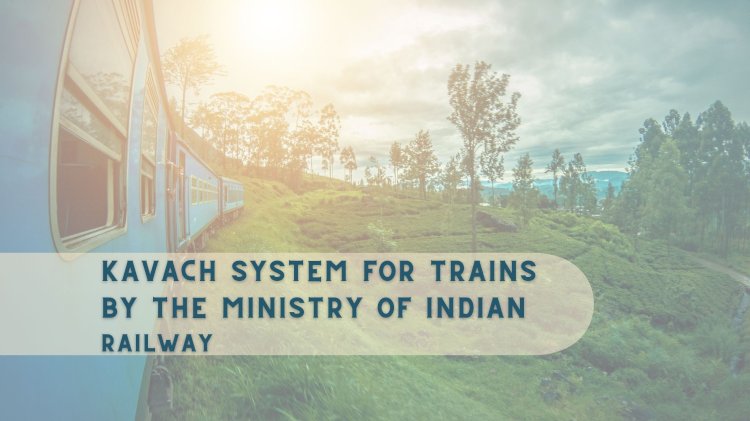Kavach System for Trains by Ministry Of Indian Railway
The implementation of an Automatic Train Protection (ATP) system known as Kavach in the Indian Railways has been a significant initiative to enhance safety and prevent accidents. Developed jointly by the Ministry of Indian Railways and RDSO, Kavach is designed to provide essential protection to trains against signal violations, excessive speed, and collisions. With continuous updates on Movement Authority and automatic brake application during unsafe situations, Kavach aims to ensure the safety of train operations. The system utilizes RFID tags placed on tracks to determine the distance between trains and employs radio communication between the stationary unit and train unit for signalling information transfer. Kavach's successful field trials and demonstrations have shown promising results, making it a cost-effective solution compared to similar systems worldwide. However, despite its potential, the complete implementation of Kavach across the rail network is still pending, leading to
By Shreya Rajvanshi Gangal

The Odisha Train Accident on July 2nd,2023, left a huge question mark on the Indian Ministry of Railway's Networking system. making the whole nation Question what all railways are doing to prevent these types of Tragedies in future. In all this Chaos Railway Ministry was again and again questioned about the Collison Proof system Promised by the ministry. Today Let us talk about that Collision Proof system named The Kavach System.
In the year 2012, the Ministry of Indian Railways and RDSO(Research Design and Standard Organisation) joined hands and started working on an Automatic Train Protection (ATP) system with the motive of Zero accidents in railways. This resulted in TCAS (Train Collison Avoidance System) or Kavach System.
Kavach is an indigenously developed ATP System meant to provide protection to trains against Signal Passing at Danger (SPAD), excessive speed, and collisions. It provides continuous updates on Movement Authority which is the distance up to which trains are allowed to travel without facing any danger. During unsafe situations when brake application is necessary but the Crew has either failed to do so or is not available, brakes are applied automatically. Its additional features include displaying information (speed, location, distance to signal ahead, Signal aspects, etc.) in Loc Pilot’s cab and generation of Auto and Manual SOS messages from Loco as well as the Station unit in case of emergency. The Communication between Stationary TACS and Loco TACS is SIL-4 certified, while Loco TACS to Loco TACS communication, Non-Signalling based additional collision protection features (i.e. Head-on, Rear end, and Side collision) and manual SoS are non-SIL(not failsafe).
RFID (Radio Frequency Identification) tags are placed on the tracks after a certain distance to determine the distance between two trains by Comparing the Absolute location of two RFID tags passed by the train. The distance traversed beyond an RFID tag on Rail-road Tie through a speed sensing arrangement (Tachometer) givetrain's location the train. The interface between two stations interlocking to that track occurs for the extraction of dynamic Signalling information. Radio communication between the Stationary unit and the Train unit happens through dynamic TDMA on specific frequency pair in the station area to transfer signalling-related information from Station Kavachto Train as per SIL-4 (Safety Integrity level 4). In block sections, in the station aemergenciessituations a Loco to Loco message is broadcast. The Stationery TCAS unit shall transmit this information to Loco TCAS and reduce the movement authority (distance trains are allowed to go without danger) to zero. If the Loco pilot fails to stop the train, Brakes are applied automatically, thus preventing SPAD. Through the conflict between signal aspects, point position, berthing track section, signal aspect sequence, and TIN in the station area and through the TIN conflict in the block section prevention of collisions between two trains is done.
Other than that Centralized monitoring of TCAS-equipped trains and stations, Secure radio communication between Stationary TCAS and Loco TCAS, and Real Time Clock (RTC) Synchronization through GPS are the additional features of Kavach.
Its first field trials were carried out in 2016 and then based on the feedback, initial specifications were formulated by March 2017. A live demonstration of the working of Kavach happened on March 4, 2022, between Gullaguda and Chitgidda railway stations in Secunderabad Division. Indian Railways Minster Ashwini Vaishnaw and Vinay Tripathi, Chairman, and CEO, of the Railway Board were travelling on different locomotives on the same track at the same time respectively. Kavach system on detecting the locos on the same track, applied breaks automatically, thus avoiding collision and making the demonstration a success.
Once implemented, it will be the world’s cheapest automatic train collision protection system, costing Rs.50 lakh per km to operate compared to about Rs. two crores worldwide. The Union budget of India for the FY 2022-2023 allocated funds for speedy implementation on the 34,000 km track of the Golden Quadrilateral rail route which is planned to be implemented by 2027-28. (source-Wikipedia)
Being a huge project itself, This system is yet to be implemented pan India which caused many accidents. The latest Odisha Train Accident is also the result of incomplete implementation of the Kavach system.
In conclusion, the recent Odisha train accident has underscored the pressing need for the widespread implementation of the Kavach System throughout the Indian railway network. Developed by the Ministry of Indian Railways and RDSO, this Automatic Train Protection (ATP) system is designed to prevent accidents caused by signal violations, overspeeding, and collisions. Although successful trials and demonstrations have been conducted, the system is yet to be fully implemented nationwide. The allocation of funds and plans for implementation on the Golden Quadrilateral rail route offer hope, but it is crucial to expedite the comprehensive adoption of the Kavach System. This will play a vital role in preventing future tragedies and realizing the vision of zero accidents in India's railway network. Swift and thorough efforts by the Ministry of Indian Railways are imperative to ensure the safety of the millions of passengers who rely on the railways for their daily transportation needs.
What's Your Reaction?



















